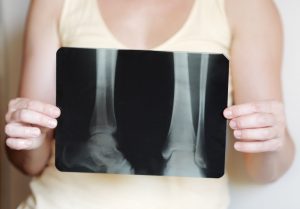 Bone marrow is a spongy tissue located inside bones that is vital for the production of important constituents of the blood such as white and red blood cells. Microscopic fractures in the internal bone structure lead to bleeding and inflammation within the marrow. These abnormalities are called bone marrow edema or “bone bruising.”
Bone marrow is a spongy tissue located inside bones that is vital for the production of important constituents of the blood such as white and red blood cells. Microscopic fractures in the internal bone structure lead to bleeding and inflammation within the marrow. These abnormalities are called bone marrow edema or “bone bruising.”
This swelling leads to pain that can feel like a soft-tissue bruise — hence the nickname “bone bruise.” Sometimes bone marrow edema does not have any noticeable symptoms. Other times it results in dysfunction of the bone or joint. Symptoms depend on the underlying causes and severity of the edema.
How Do You Get Bone Marrow Edema?
A common cause is trauma to the area. Trauma caused by acute injury or repetitive overuse wears down tissue over time. Other causes include:
- Damage to the cartilage surface of the joint due to arthritis
- Injury to a ligament
- Synovitis or “joint inflammation”
- Osteonecrosis, a specific condition that causes interruption of the blood supply to the bone which in turn weakens the bone leading to fractures
- Bone tumors
How to Detect Bone Marrow Edema
With Magnetic Resonance Imaging (MRI) technology, doctors are now able to produce detailed images of the body’s soft tissues — including bones — using magnetic fields and radio waves. With these images, they can spot abnormalities in the bone tissue indicative of fluid accumulation. Doctors were unable to spot this injury before MRIs, so it was not recognized in the medical community. Long-term effects of bone edema are still being studied.
Treating Bone Marrow Edema
The treatment of bone marrow edema often depends on the underlying causes. The most effective treatment for bone marrow edema caused by trauma is rest and relief from stress. Most surgeons recommend limiting activity when bone bruising is found, especially if it is near a joint. Other options for treatment include medication, steroid injections, and surgery. A doctor should only suggest surgery if non-surgical treatments consistently fail.
Typically bone bruises heal four to 12 months after the injury. However, 10 to 15 percent of people diagnosed with bone marrow edema still have the injury up to two years after the initial injury. For some people, the conditions of the bone bruising can be indefinitely persistent.
Dr. Stacie Grossfeld has over 10 years of experience detecting and treating bone marrow edema and its related symptoms for patients in the Louisville and Kentuckiana area. If you would like more information on “bone bruising” or think you may be experiencing bone marrow edema, contact Orthopaedic Specialists today at 502-212-2663.

Recent Comments